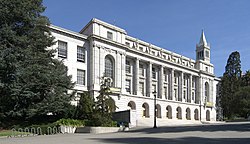Wheeler Hall
Wheeler Hall | |
 Front of Wheeler Hall | |
37°52′15.7″N 122°15′32.6″W / 37.871028°N 122.259056°W / 37.871028; -122.259056 | |
| NRHP reference No. | 82004654 |
|---|---|
| BERKL No. | 163 |
| Significant dates | |
| Added to NRHP | March 25, 1982 |
| Designated BERKL | January 13, 1986[1] |
Wheeler Hall is a building on the campus of the University of California, Berkeley in Berkeley, California in the Classical Revival style. Home to the English department as well as the university's College Writing Programs department, it was named for the philologist and university president Benjamin Ide Wheeler.
The building was opened in 1917.[2] It houses the largest lecture hall on the Berkeley campus, Wheeler Auditorium.
On February 29, 1940, UC Berkeley professor Ernest O. Lawrence received the Nobel Prize in Physics in Wheeler Auditorium from Carl Wallerstedt, Consul General from Sweden, due to the danger of crossing the Atlantic during World War II. The building was the site of many of the Free Speech Movement protests in the 1960s and is a focal point of the Berkeley campus. In the 2010s, it has been the place for many university protests and several building takeovers.
Footnotes
- ^ "Berkeley Landmarks". Berkeley Architectural Heritage Association. Retrieved 2013-03-04.
- ^ University of California chronicle. Vol. XIX. University of California Press. 1917. p. 75.
External links

- Interactive Map of Berkeley Campus
- v
- t
- e
- College of Chemistry
- College of Computing, Data Science, and Society
- College of Engineering
- College of Environmental Design
- College of Letters and Science
- Goldman School of Public Policy
- Haas School of Business
- Herbert Wertheim School of Optometry and Vision Science
- Rausser College of Natural Resources
- School of Education
- School of Information
- School of Journalism
- School of Law
- School of Public Health
- School of Social Welfare

| Programs | |
|---|---|
| Rivals | |
| Culture |
|
| Academic buildings |
|
|---|---|
| Landmarks | |
| Student activities | |
| Residential |
- Founded: 1868
 | This Alameda County, California building and structure-related article is a stub. You can help Wikipedia by expanding it. |
- v
- t
- e
 | This article about a property in Alameda County, California on the National Register of Historic Places is a stub. You can help Wikipedia by expanding it. |
- v
- t
- e












